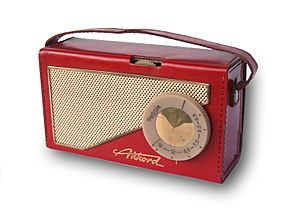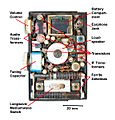Transistor radio facts for kids
A transistor radio is a type of radio that uses tiny electronic parts called transistors to make sounds louder. These radios are often small and don't need much electric power to work. They can even pick up weak radio signals that older radios might miss. Transistor radios became very popular in the late 1950s because they were easy to carry around. Soon, radios that used vacuum tubes became less common.
Contents
How Transistor Radios Work
Small Parts, Big Sound
Transistor radios get their name from transistors. A transistor is a tiny electronic switch that can also make an electrical signal stronger. In a radio, transistors help to amplify, or boost, the weak radio waves that come from the air. This makes the sound loud enough for you to hear.
Powering Your Portable Radio
One cool thing about transistor radios is how little power they need. This means they can run on small batteries for a long time. Because they are so power-efficient, they were perfect for taking with you on the go. You could listen to music or news almost anywhere!
The History of Transistor Radios
A New Era of Listening
Before transistor radios, most radios used vacuum tubes. These tubes were bigger, used more power, and could break easily. In 1954, the first commercial transistor radio, the Regency TR-1, was sold. It was a big step forward!
Becoming Super Popular
By the late 1950s and 1960s, transistor radios became extremely popular. Companies like Sony started making many different models. They were often small enough to fit in your pocket. This made listening to the radio a personal experience, not just something you did at home.
Why They Were a Hit
Transistor radios changed how people listened to music and news. They were:
- Portable: Easy to carry anywhere.
- Affordable: Many models were not too expensive.
- Durable: Less likely to break than tube radios.
- Efficient: Used very little battery power.
These features made them a must-have gadget for many people, especially teenagers!
Images for kids
-
Sanyo 8S-P3 transistor radio, which received AM and shortwave bands.
See also
 In Spanish: Transistor (radiorreceptor) para niños
In Spanish: Transistor (radiorreceptor) para niños








